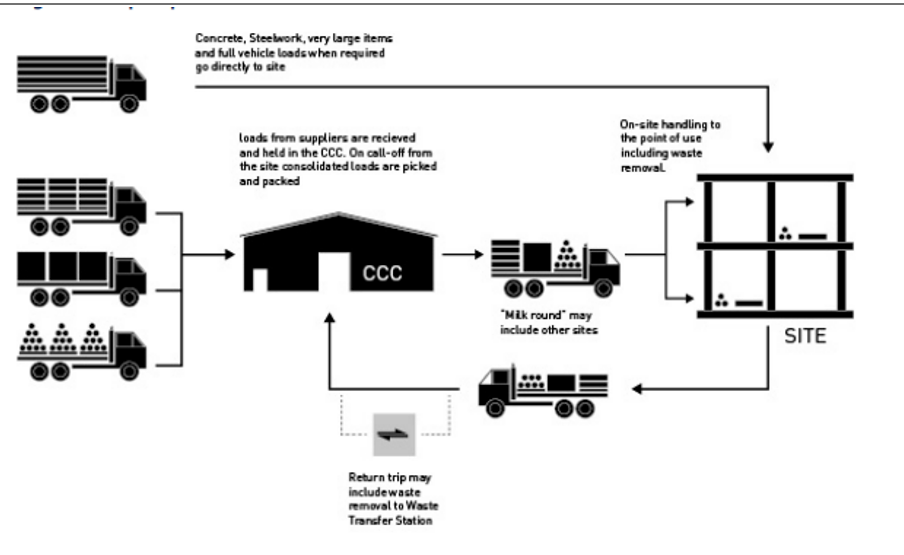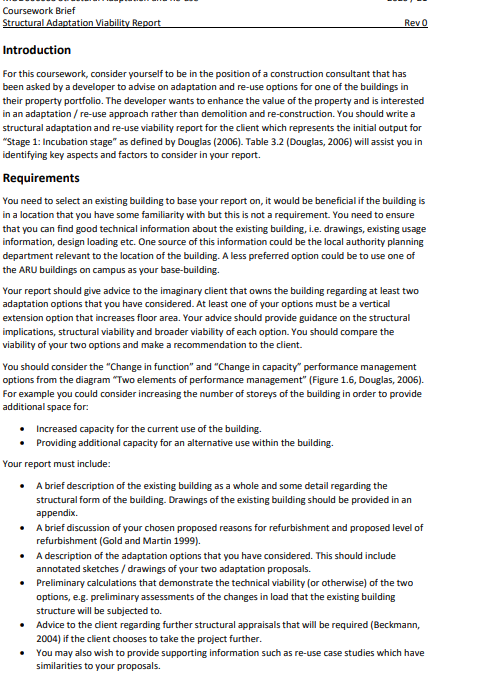MOD006603 Structural Adaptation and Re-use Assignment
Introduction:
Here is a sample for” MOD006603 Structural Adaptation and Re-use Viability Report “
Collaborative procurement is referred or can be defined as the “centralization or consolidation of popular and routine procurement of goods and services through several organisations or establishments.” It generally relieves or helps in releasing pressure on public segment budgets while still allowing programmes to be extended as far as possible. Procurement is the procedure of purchasing products and services that your business requires to run its operations. This encompasses a wide range of other programmes, including contract adjudication, funding, and more.
Any course involved in getting goods into the hands of customers is referred to as supply chain management. Conventional construction site transport or transport facility is often uncoordinated and unplanned, with several separate deliveries and a high risk of damage. At the site’s entry and unloading areas, there is a lot of traffic. Many vehicles arrive half-full and leave clean, resulting in carbon emissions that are out of proportion to the tonnage treated. Full loads, on the other hand, result in an overabundance of material on site, causing a clogged work environment as well as unnecessary material waste and damage.
Section A (ii) Body
Collaborative procurement encompasses a wide range of supply chain activities, including manufacturers, retailers and wholesalers whereas A consolidation centre in the construction sector is a distribution facility or a delivery facility that is used in managing the logistic project managing single or multiple construction sites, channelling the material deliveries to large medium or single number of different sites. It is a process centre for efficient delivery or distribution management.
The Four benefits of collaborative procurement systems are as follows:
Cost saving and managing of cost efficiency- Consumers may believe they are receiving the most excellent price from their suppliers, but due to budget constraints in the public sector, Will Laing, financial account director at the Crown Commercial Service (CCS), says there has been a push for more cooperation in procurement. There is much need to widen or expand public funds as far as possible to ensure that public amenities can be rendered and teamwork can help authorities save money.
Authorities also revolve to establishments or association like the CCS for assistance and support in pooling demand and implementing procurements in order to deliver predictable costs for the same goods or services.
Minimising efforts of duplication- Nichola Cooke has explained, a joint procurement service in the Greater Manchester region, demonstrated how collective procurement can save money by minimising duplication of effort. Although Cooke believes that teamwork is advantageous to procurement, he also believes that only working with those who want to work with you is crucial. Working with the willing alliance, with people who want to work together with you, while you try to push cooperation, a lot of problem will arise in this case.
Marinating relationship with the suppliers- Partnership or collaborative team also allows procurement group or division to be better clients to their suppliers, according to Michael Pace, managing director of NHS London Procurement Partnership. Evidently, consumers are significant, and know and understand the crucial perspective of their need and demands.
So it is better to discuss and explain the requirements to the vendors as the technology keeps on changing and evolving which will be helpful concerns for the long term partnership and relationship. Procurement collaborations can gain a greater understanding of what they can create by partnering with manufacturer, while listening knowing their skills, and appreciating the creativity.
Additional help/assistance and expertise- As described or explained by Louise Capel-Cure, contracts modernization programme executive at the London Mayor’s bureau for crime and Policing, partnership in procurement will assist commissioners on topics like social assessment, value and charges (MOPAC). MOPAC is able to sketch on knowledge and expand insight into practise by collaborating with procurement partnerships, according to Capel-Cure. It is been said that access to the area’s central personnel, who assists us in determining the proper integration of all facets of a accountable procurement scope into our commission processes, sometimes comes naturally.
The basic goals of the collaborative procurement system or strategy are:
- To maximise the potential for aggregation by CPD and its consumers or customers all by category management
- Opportunity exploration for collaboration between the procurement expertise centres on an decided variety and choice of services and supplies.
- Allowing the CPD to standardise the prices across the centres of procurement expertise and other jurisdiction authority
- Benefits or settlements from the aggregated arrangements all established by crown commercial service and amenities or its partners
Section B: (i) Body:
A Construction Consolidation- Centre (CCC) is a distribution hub that funnels raw material deliveries, which can be referred as a small warehouse of material processing equipment where vehicles can be easily offloaded and turned around.

Urban regions of the European area focus over 60% of the population, which generates a dynamic economic commotion (represent 85% of the unions GDP), which needs a very large amount of goods and community. 40% of all CO2 emissions is due to urban transport and responsible for 70% of other pollutants (2017a European commission), thus resulting in poor air quality, pollution, congestion and noise.
A proper and efficient transport system is required in keeping in the mind the main topic of urban mobility, a special focus is needed for transportation in the urban areas i.e., urban logistics which represents a particular share and amount of urban traffic, but the main problem or difficulty arises as the urban logistic is not even considered in the urban planning process, which results in the major or key for sustainable functioning and growth of the cities. The building sector consumes the most electricity (40%) and emits about a third of all greenhouse gas emissions in the European commission (European assignment, 2017b).
The SUCCESS project intended to increase the efficiency of trips connected with the distribution of goods, commodities, cargo, waste and services in EU cities by focusing on the construction sector or industry as a field with a significant effect on city logistics. This project goal focuses on the availability and providing tools and solution to the challenges; in the urban transportation, freight as well as introduce more resource efficient, safer and seamless supply chains and more environmentally friendly innovations.
The final statement, titled “Final validation report for each site and long-term site implementation plan,” seeks to determine how construction logistics problems can be incorporated into future urban policies in the long run; taking into account private and public shareholder engagement, time plans message strategies, challenges, and steps to be taken.
The report recognized several obstacles to effectual construction consolidation centre, including the inability to assess the financial feasibility and demand for CCC initiatives, planning challenges (including location, land availability, the lack of integrated supply chains, and price) operations challenges (lack of buying procedures, creativity and outsourcing), and building logistics remains a niche topic.
The statement identifies the supporting elements (city logistics legislation, competences, and collaboration, standards and training,) as well as the obstacles to the execution and long-term sustainability of construction transportation initiatives and CCCs. In the case of CCCs, it is apparent that the satisfactory implementation of a CCC must be evaluated on a case-by-case basis and is dependent on a number of elements.
In reality, CCCs can be financially self-sustaining even without government support, but they must be situated in an environment that ropes their development (in conditions of, chosen business model, political environment geographical location etc.). The capability to achieve economies of scale to compensate for the extra expense is critical to the viability and sustainability of a CCC, so the existence of large building sites or the option of a CCC serving several sites appears to be the most economically viable in the long run.
It’s worth noting that construction delivery and transport is an intrinsically complicated industry with a diverse set of stakeholders with competing security. Many, and often opposing, factors will constrain the transition to more regularised and efficient logistics, such as the need for decarbonisation and the need for new buildings in urban centres.
Conclusion:
Due to disparities in needs and requirements, buyers and suppliers in joint procurement are vulnerable to conflict in partnership. Negotiation is an essential part of resolving a dispute. Designed to deal with the present collaborative procurement negotiation’s underdeveloped self-adaptive learning impact, this paper develops a negotiation model based on a multi-agent structure and proposes a machine learning-based negotiation optimization strategy. It offers a fresh perspective on intelligent SCM research. When opposed to the single-learner approach, the experimental findings show that the proposed strategy increases the success rate of self-adaptive learning and mutual utility of agents.
The main link in the growth of the entire organisation is procurement, which has a direct impact on production and operations. As a result of the fierce market competition, buying behaviour increasingly changes from conventional independent purchasing, which has issues with small quantity discounts, low negotiating power, and sluggish response to consumer demand, to collective procurement.
The European commission made the Green Deal on smart and sustainable mobility solutions for EU transports or logistics in order to increase city liveability and achieve a 90 percent reduction in logistic emissions by 2050. Municipality or metropolis logistics solutions that focus on zero-emission cars, smart distribution designs, and preparation and management of material logistics are all part of the Green Deal.
References:
Chifuti, C. and Kasongo, R.M., 2020. FACTORS AFFECTING PROCUREMENT PERFORMANCE IN NON-GOVERNMENTAL ORGANIZATION IN ZAMBIA. International Journal of Supply Chain Management, 5(1), pp.87-101.
Chiru, M. and Enyedi, Z., 2021. Who wants technocrats? A comparative study of citizen attitudes in nine young and consolidated democracies.
Elhag, T., Eapen, S. and Ballal, T., 2020. Moderating claims and disputes through collaborative procurement. Construction Innovation.
Kwofie, T.E., Aigbavboa, C. and Thwala, W., 2020. Non-traditional Procurement Systems. In Effective Construction Project Delivery (pp. 47-72). Springer, Cham.
Kwofie, T.E., Aigbavboa, C. and Thwala, W., 2020. The Case of Non-traditional Procurement Systems and Communication. In Effective Construction Project Delivery (pp. 29-38). Springer, Cham.
Paschen, J., Wilson, M. and Ferreira, J.J., 2020. Collaborative intelligence: How human and artificial intelligence create value along the B2B sales funnel. Business Horizons, 63(3), pp.403-414.
Rezaei, J., Pourmohammadzia, N., Dimitropoulos, C., Tavasszy, L. and Duinkerken, M., 2020. Co-procurement: making the most of collaborative procurement. International Journal of Production Research, 58(15), pp.4529-4540.
Rosli, A., Mak, W.J., Richard, B., Meor Hashim, M.M., Arriffin, M.F. and Mohamad, A., 2021, March. Closed-Loop Data Analytics for Wells Construction Management in Real Time Centre. In International Petroleum Technology Conference. OnePetro.
Sarhan, S., Pasquire, C., King, A. and Manu, E., 2018. Institutional waste within the UK construction procurement context: A conceptual framework. Engineering Project Organization Journal, 8, pp.36-64.
Valaguzza, S., 2019. How Does Collaborative Procurement Operate in I taly?. Collaborative Construction Procurement and Improved Value, pp.445-460.
Know more about UniqueSubmission’s other writing services:


